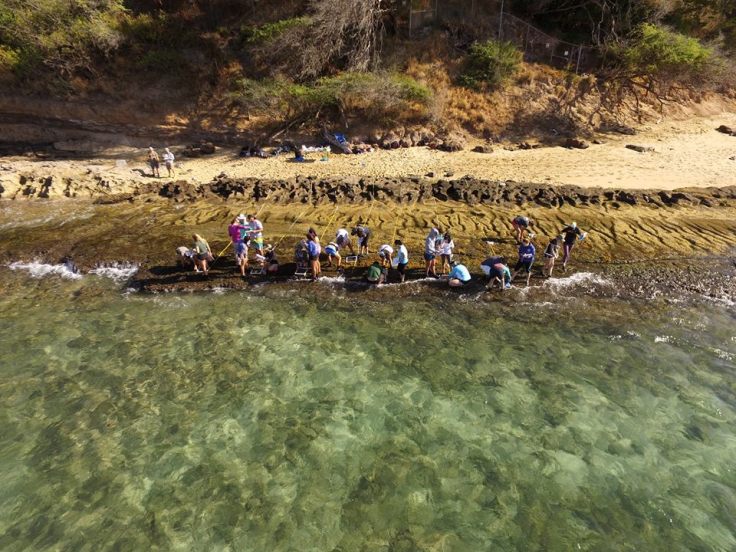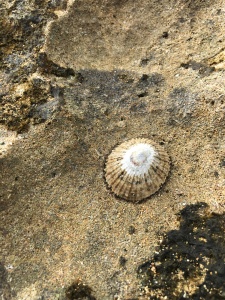Contributed by: Jessica Schaefer
Half a dozen bright yellow measuring tapes snake through the water, lined up perpendicular to the shoreline along a rocky stretch of coast. Under a bright sun, teams of middle schoolers work along the transect lines, counting, recording notes, shouting out Hawaiian or Latin names, and fighting a losing battle to keep their lines straight as the tide comes in and waves crash around them. There is a feeling of joyful, barely-contained chaos. The students on this field trip have a job to do, and they know it. They have prepared and practiced in the classroom for weeks leading up to this day. Nonetheless, when they find themselves knee-deep in the ocean, surf up, supplies floating away, distracted by odd and wonderful organisms, the details of methods and taxonomic nuance sometimes escape them . . .

These kids are citizen scientists participating in Our Project in Hawaii’s Intertidal (OPIHI), a program led by Joanna Philippoff and colleagues from the UH Mānoa Curriculum Research & Development Group. The students are tasked with a job too big for any graduate student or single research team: monitor the biodiversity of Hawai’i’s rocky intertidal, the zone along the coast exposed to the air during low tide and submerged by the ocean at high tide. The intertidal is both fascinating and ecologically important, as it is the transition between land and sea, harbors a high number of species, and forms connections to coral reefs. The intertidal is also economically and culturally important as a source of limu (algae) and animals such as ‘opihi (limpets), which are harvested by native Hawaiians.
Given the scarcity of very low tides during daylight hours, crowd-sourcing using citizen science allows us to survey Hawaiian intertidal habitats efficiently and cover a larger geographic scale than would otherwise be possible. OPIHI students, from 5th–12th grade classes, monitor the diversity and abundance of algae and invertebrates using the same methods and procedures utilized by ecologists. In the past two years, approximately 80 classes from 45 schools have collected data at 38 different locations on six islands! In addition to collecting rigorous biological data, classes test water quality parameters (including temperature, dissolved oxygen, salinity, and turbidity) and develop their own hypotheses about how these factors affect the organisms living at their intertidal site. OPIHI provides opportunities for students to contribute to authentic research, which has scientific benefits, but also has equally important educational benefits: participants learn important scientific concepts such as sampling and develop their scientific curiosity while exploring marine environments right in their backyard—perhaps even seeing these places with new eyes.
In 2013, the first inter-island description of Hawaiian intertidal communities was published based on OPIHI citizen science data collected over a decade ago (Cox et al. 2013). Preliminary analyses of OPIHI data from the last two years suggests some of these communities have changed over time and that species assemblages are highly site-specific and vary by substrate type (e.g., basalt or limestone). I am currently involved in preparing a scientific publication assessing this change in Hawaiian intertidal communities (including the abundance of invasive species), something unachievable without the help of hundreds of students across the state.

My own marine research career began in the rocky intertidal of Panamá, where I studied the mating system of the giant limpet Siphonaria gigas. So, when I heard about a project devoted to the Hawaiian intertidal during my first year in graduate school, I was keen to get involved. After being invited once, I began attending OPIHI meetings regularly as a volunteer/groupie, which turned into a graduate assistantship the next semester. In hindsight, I believe this illustrates the power of being present. The best way to demonstrate your enthusiasm for something is to show up and start doing it, even before you have the job. This was not my conscious intention when I started attending OPIHI meetings—I just thought it was a cool program and the people were really great—but it ended up working to my benefit when I obtained the graduate assistantship.
As a citizen science project, OPIHI has both educational goals and scientific research objectives, so working on the project allowed me to enter the realm of education while remaining grounded in what I am more familiar with. As someone who is not sure if I want to pursue a career in academia, I value the opportunity to focus on educational aspects of science and develop new skills, such as project management, working with teachers, and learning about the Next Generation Science Standards (NGSS), which are being adopted by many state school systems. In addition, I have utilized and strengthened my research skills and intertidal knowledge. OPIHI is an evolving program and through presentations on OPIHI at education conferences such as HaSTA, the Hawai’i Science Teachers Association, and HERA, the Hawai’i Educational Research Association, we shared insights we have gained into factors that contribute to data quality in citizen science. For instance, to evaluate data quality and decide whether or not a field trip will be included in our scientific analyses, we take into consideration sample size, consistency across transects, and species richness. Surprisingly, we found there is no correlation between the age of students and whether their field trip data is included or excluded from our scientific analyses (unpublished data, Philippoff et al. 2018). In addition, as teachers participate in OPIHI for multiple years, their field trip data is more likely to be included, even though every year they have a new class of students collecting the data.

OPIHI is a wonderful marriage of science and education for me. It provides the rewarding personal connections and feel-good satisfaction that I miss when only focusing on scientific research. Although I thrive on intellectual challenge, problem-solving, and the step-by-step, methodical path to scientific discovery, I am also fueled by the interactions and relationships I develop through teaching. The way I see it, the job of a teacher is first to sleuth and understand students’ thought processes, and then creatively find the best way to teach them—ideally by leading them to figure stuff out for themselves. I watch the lightbulbs go on in students’ heads, and those small victories for both my students and me are extremely gratifying.
My personal aims in teaching are analogous to the educational goals of OPIHI: get kids to make connections and empower them to see themselves inhabiting a role they may not have previously imagined. OPIHI students make connections about the natural world: between watersheds and ocean, from mauka to makai, and between humans, their environment, culture, and resources. The students see themselves as scientists. And that is something I love being a part of.
To find out more about OPIHI or volunteer on a field trip, visit the OPIHI website or email Joanna Philippoff at philippo@hawaii.edu or the author at jschaef@hawaii.edu
About the author:
Jessica is currently a graduate student at the University of Hawai’i at Mānoa in the Department of Biology. She is from Wisconsin and an alumna of the University of Notre Dame, where she played clarinet in the marching band and began her research career studying lake ecology and largemouth bass. Her marine interests led her to Panamá, where she researched adaptive benefits of reproductive behaviors in the giant intertidal limpet, Siphonaria gigas, while working at the Smithsonian Tropical Research Institute. Jessica’s Master’s thesis in Dr. Peter Marko’s lab involves a paternity study of Siphonaria gigas embryos to determine whether monogamous pairs of limpets mate exclusively with each other. In Hawai’i, Jessica loves hiking, snorkeling, dancing, doing yoga, and tide pooling, although she sometimes misses a good midwestern snowstorm.




Leave a comment